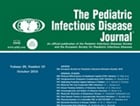Materials and Methods
Active Bacterial Core surveillance (ABCs), a component of the Centers for Disease Control and Prevention's Emerging Infections Program, conducted active, population-based surveillance for infants with EOS. Cases were defined as infants ≤2 days of age (0–72 hours of life), >22 weeks gestation, with one or more bacterial organisms isolated from either blood or cerebrospinal fluid (CSF), and live birth at a hospital in California (3-county Bay area), Connecticut (statewide), Georgia (8-county metro Atlanta area), and Minnesota (statewide, surveillance started in 2006) during 2005 to 2008. The surveillance population included approximately 159,000 live births in 2005, and approximately 233,000 live births annually from 2006 to 2008. Organisms that we classified as possible contaminants, such as coagulase-negative staphylococci (CoNS), Corynebacteria, and diphtheroids, were excluded. Maternal and infant demographic and clinical information were abstracted from the labor and delivery and medical chart records using a standardized form. Isolates were not collected; however, antimicrobial susceptibility was abstracted from infant medical charts.
Preterm births were defined as births at less than 37 weeks' gestation; number of days of gestation was not collected. Two categories for race were used: black and nonblack (which included white, Asian or Pacific Islander, and American Indian or Alaska Native). Outcome was based on the known status of the infant at hospital discharge; cause of death was not collected. E. coli cases with missing susceptibility results were excluded from calculations of ampicillin-resistant E. coli incidence. Surveillance-area incidence was calculated using live birth data from state vital records as the denominator; 2007 data were used for 2008.
To estimate the number of EOS cases nationally, we applied race (black, nonblack)- and gestational age (preterm, term)-specific incidence to the number of US live births, obtained from the National Center for Health Statistics Vital Stats online birth and population files.[10] Preliminary denominators (98% complete) for 2007 were used for both 2007 and 2008. Missing race and gestational age for the numerator and live birth denominators were distributed according to those with known race and gestational age within the relevant surveillance area for each year. Confidence intervals (CI) around the standardized incidence rates, case fatality ratios, and burden estimates were calculated using a method derived from the gamma distribution.[11]
We compared burden estimates based on ABCs to estimates based on data from the National Institute of Child Health and Human Development (NICHD) Neonatal Research Network's (NRN) independent, multisite EOS surveillance study.[12–15] For the NICHD NRN study, cases were defined as illness in infants of all gestational ages weighing >400 g at birth with the isolation of a bacterial organism from blood or CSF culture obtained in the first 72 hours of life and birth in one of 16 academic centers (Sidebar) during 2006 to 2008. The surveillance population included approximately 93,000 live births in 2006, and approximately 103,000 live births annually from 2007 to 2008. Stillborn infants and infants who died in the delivery room as well as possible contaminants, such as Corynebacteria and diphtheroids, were excluded. Neonates positive for CoNS were only included as cases if more than 1 culture was positive and if the infant was continued on antibiotic therapy for 5 or more days. However, to improve comparability with ABCs for this analysis, we excluded all CoNS from estimates derived from the NRN data.
Incidence in the NICHD NRN system was calculated based on live births in participating hospitals; race and gestational age were not collected for this denominator. To compare burden estimates across systems, national EOS estimates based on ABCs were adjusted for gestational age only and those for the NICHD NRN were adjusted for birth weight category (401–1500 g, 1501–2500 g, and >2500 g), for the years 2006 to 2008. All analyses were performed using the SAS software system, version 9.1 (SAS Institute Inc., Cary, NC).
Pediatr Infect Dis J. 2011;30(11):937-941. © 2011 Lippincott Williams & Wilkins
Cite this: The Burden of Invasive Early-onset Neonatal Sepsis in the United States, 2005–2008 - Medscape - Nov 01, 2011.





Comments